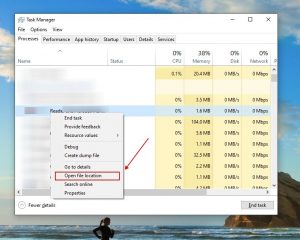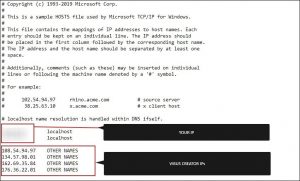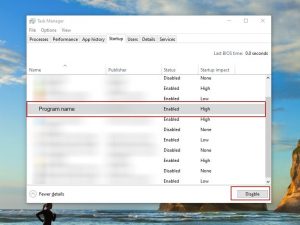This article intends to help you delete Mool Ransomware at no cost. Our instruction also explain how any .mool files can be decrypted.
About Mool
Mool Ransomware stands for a cryptovirology COMPUTER hazard made use of to blackmail its victims. Mool Infection may not indicate any kind of noticeable signs, yet its presence is just uncovered as quickly as its job is performed.
The lack of symptoms is just one of the major problems with this type of COMPUTER infections. They can pass through right into the struck system unnoticed, and also implement their work without revealing their task in the workstation. This is why most consumers are unable to do anything to terminate the infection prior to it has actually finished its mission, and the mission of this one, in particular, is to make its targets' data pointless using information ciphering and then indicating a ransom demand.
The customer is reported via a message that this infection places on their display that their only solution of bringing their data back is by means of the payment of a particular quantity of funds. This blackmailing component of this scam is popular among the fraudulences, and there's an entire team of COMPUTER malware that's used in this way. This malware group is named Ransomware, as well as the malware we are presently focusing on certainly falls under it.
The Mool malware is only disclosed once it has completed encrypting the files. The .mool Ransomware will then express its needs using an daunting pop-up alert.It is through this alert that the users learn exactly how they are anticipated to move their funds to the cyber frauds responsible for the Ransomware virus. In most instances, the ransom would be asked in a cryptocurrency - BitCoin. These cryptocurrencies are actually hard to trace, and also a regular customer would certainly have no chance of understanding who they are really transferring their funds to. This, as a matter of fact, makes it truly not likely that the cyberpunk's true identification would certainly ever obtain revealed. It is fairly unusual for a Ransomware hacker to stand on trial, and the application of cryptocurrency as the recommended settlement option is the primary reason for that.
Below you can discover the quotation from the Mool text file:
ATTENTION! Don't worry, you can return all your files! All your files like photos, databases, documents and other important are encrypted with strongest encryption and unique key. The only method of recovering files is to purchase decrypt tool and unique key for you. This software will decrypt all your encrypted files. What guarantees you have? You can send one of your encrypted file from your PC and we decrypt it for free. But we can decrypt only 1 file for free. File must not contain valuable information. You can get and look video overview decrypt tool: https://we.tl/t-2P5WrE5b9f Price of private key and decrypt software is $980. Discount 50% available if you contact us first 72 hours, that's price for you is $490. Please note that you'll never restore your data without payment. Check your e-mail "Spam" or "Junk" folder if you don't get answer more than 6 hours. To get this software you need write on our e-mail: restorealldata@firemail.cc Reserve e-mail address to contact us: gorentos@bitmessage.ch Our Telegram account: @datarestore
How to Mool virus encrypt your files?
The .mool Virus document encryption is not mosting likely to be removed after the ransomware is deleted. The .mool Virus document encryption access key is promised to be given to you when you pay the ransom amount.
Nonetheless, it is not uncommon for the criminals who back up such dangers to assure their victims a decryption secret for their encrypted papers just to refuse to provide that essential as soon as the repayment gets processed. Needless to state, if you wind up in a problem like this, you would not can doing anything regarding it-- your funds would be gone, as well as your data would still be inaccessible. This is why it isn't really smart idea to move the repayment, in addition, if you have not selected any kind of alternate choices that may work.
Despite the fact that we pointed out that the file encryption would continue to be on your papers even after the Ransomware is no longer in the system, erasing the virus is still extremely essential. After you remove the Ransomware, you may also attempt the alternate documents healing solutions we have actually developed for you, as well as also your new files will not be at threat of being secured. To remove this cryptoviral threat, you are suggested to complete the actions you will run into listed below.
Mool SUMMARY:
| Name | .mool Virus |
| Type | Ransomware |
| Threat Level | High (Ransomware is up until now the worst malware you can experience) |
| Symptoms | A Ransomware threat similar to this one would typically not disclose its visibility till the records obtain locked up |
| Promotion Channel | Channels like spam e-mail promotion, and malvertising are normally the ones used to spread Ransomware. |
| Data Recovery Solution | Emsisoft Decrypter |
| Detection Utility |
.mool may recover itself plenty of times if you don't get rid of its core files. We suggest downloading Loaris Trojan Remover to scan for malicious utilities. This may save you a lot of time and efforts to effectively get rid of all possible malware within your device.
Read more about Loaris Trojan Remover (License Agreement, Privacy Policy ).
If Loaris identifies a threat, you will need to buy a license to get rid of it. |
Delete Mool Virus Ransomware
Some of the steps will likely demand you to exit the page. Bookmark it to easily get back to it later.
Reboot in Safe Mode (use this tutorial if you don’t know how to do it).
Click CTRL + SHIFT + ESC simultaneously and go to the Processes Tab. Try to identify which processes are malicious.

Right click on each of them and choose Open File Location. Then inspect the documents with online file checker:
Once you open their folder, end the processes that are contaminated, then get rid of their folders.
Note:If you are specific something belongs to the threat - eliminate it, even if the scanner doesn't mark it. No anti-virus application can recognize all infections.
Keep holding the Win + R. And then copy & paste the following:
- notepad %windir%/system32/Drivers/etc/hosts
A new document will certainly open. In case you are hacked, there will be a load of other IPs connected to your device near the bottom. See the image listed below:

In case there are suspicious IPs below “localhost” – get in touch with us in the comments.
Use CTRL + SHIFT + ESC simultaneously and access the Startup Tab:

Proceed to Program Name and select “Disable”.
Keep in mind that ransomware may even include a fake developer name to its process. You must check out every process and be persuaded that it is legitimate.
To get rid of Mool Virus, you may have to deal with system files and registries. Making a mistake and getting rid of the wrong thing may hurt your device.

You can prevent the system damage by selecting Loaris Trojan Remover - a high-quality Mool removal software.
Read review about Loaris Trojan Remover (License Agreement, Privacy Policy ).
Look for the ransomware in your registries and get rid of the entries. Be very careful – you can destroy your system if you remove entries not associated with the ransomware.
Type each of the following in the Windows Search Field:
- %AppData%
- %LocalAppData%
- %ProgramData%
- %WinDir%
- %Temp%
Get rid of everything in Temp. Finally, simply check out for anything lately added. Don't forget to drop us a comment if you run into any issue!
How to Decrypt .mool files?
Djvu Ransomware essentially has two versions.
- Old Version: Most older extensions (from “.djvu” up to “.carote”) decryption for most of these versions was previously supported by STOPDecrypter tool in case if infected files with an offline key. That same support has been incorporated into the new Emsisoft Decryptor for these old Djvu variants. The decrypter will only decode your files without submitting file pairs if you have an OFFLINE KEY.
- New Version: The newest extensions released around the end of August 2019 after the ransomware was changed. This includes .coharos, .shariz, .gero, .hese, .xoza, .seto, peta, .moka, .meds, .kvag, .domm, .karl, .nesa, .boot and etc….These new versions were supported only with Emsisoft Decryptor.
"The decrypter can't decrypt my files?"
For the most part this indicates you have an on-line ID. It might likewise indicate your data were secured by a newer variant of STOP/Djvu.
- Offline ID. When the ransomware can't attach to its command and control web servers while encrypting your documents, it makes use of a built-in file encryption key and a built-in ID. Offline ID's generally end in t1 and also are generally simple to identify. Given that the offline key and ID only transform with each variant/extension, every person who has actually had their documents encrypted by the exact same variation will certainly have the same ID and the files will certainly be decryptable by the same key (or "personal key when it comes to RSA file encryption).
- Online ID. In most cases the ransomware is able to connect to its command and also control web servers when it secures files, and when this takes place the servers react by generating random keys for each and every contaminated computer. Because each computer has its own key, you can't utilize a key from an additional computer to decrypt your data. The decrypter is capable of working about this with older variations as long as it has some help, nonetheless for newer versions there is nothing that can be done to recover data.
In case when the tutorial doesn’t help, download the anti-malware tool we suggest or try free online virus checker. Furthermore, you may always ask us in the comments for assistance!


Leave a Comment